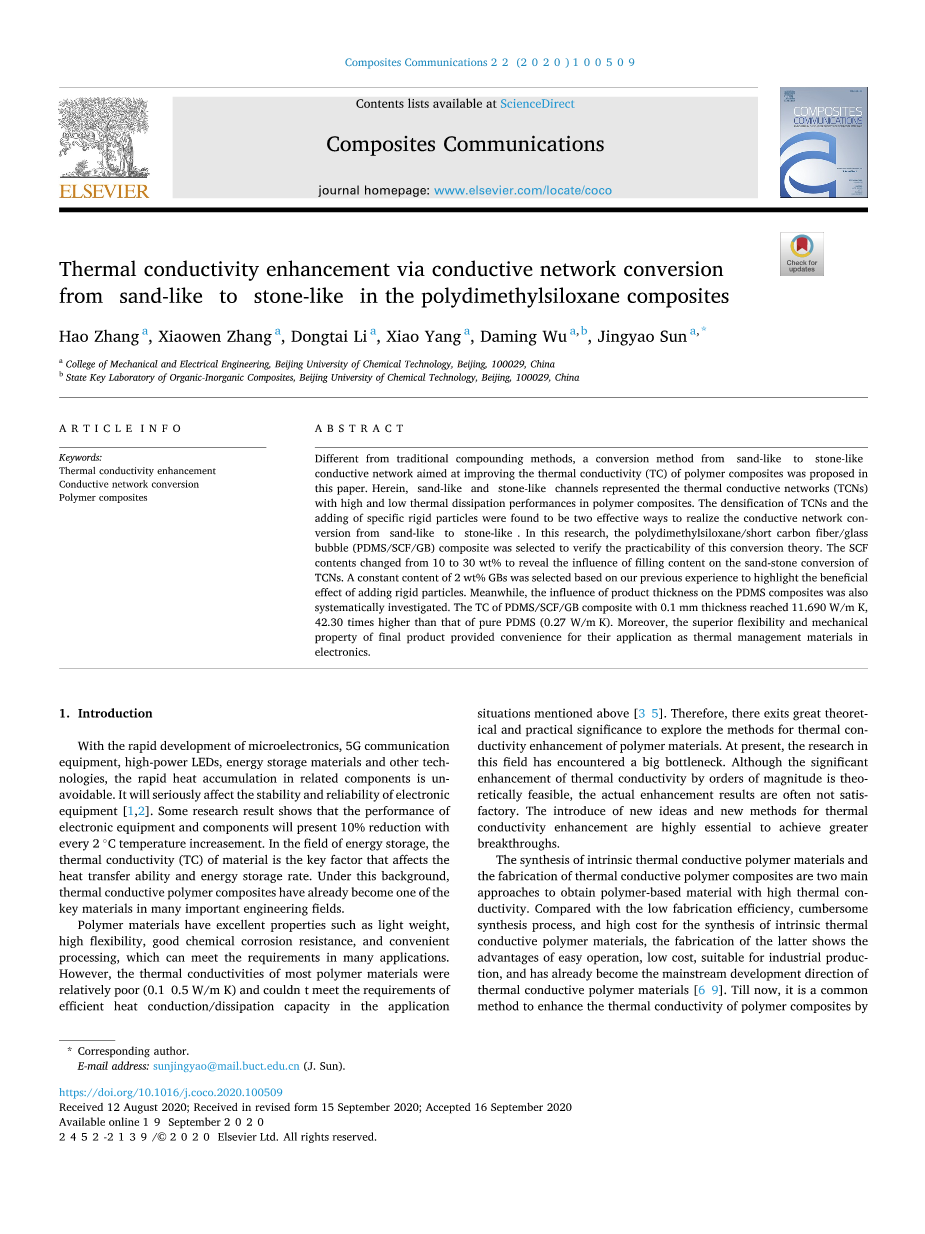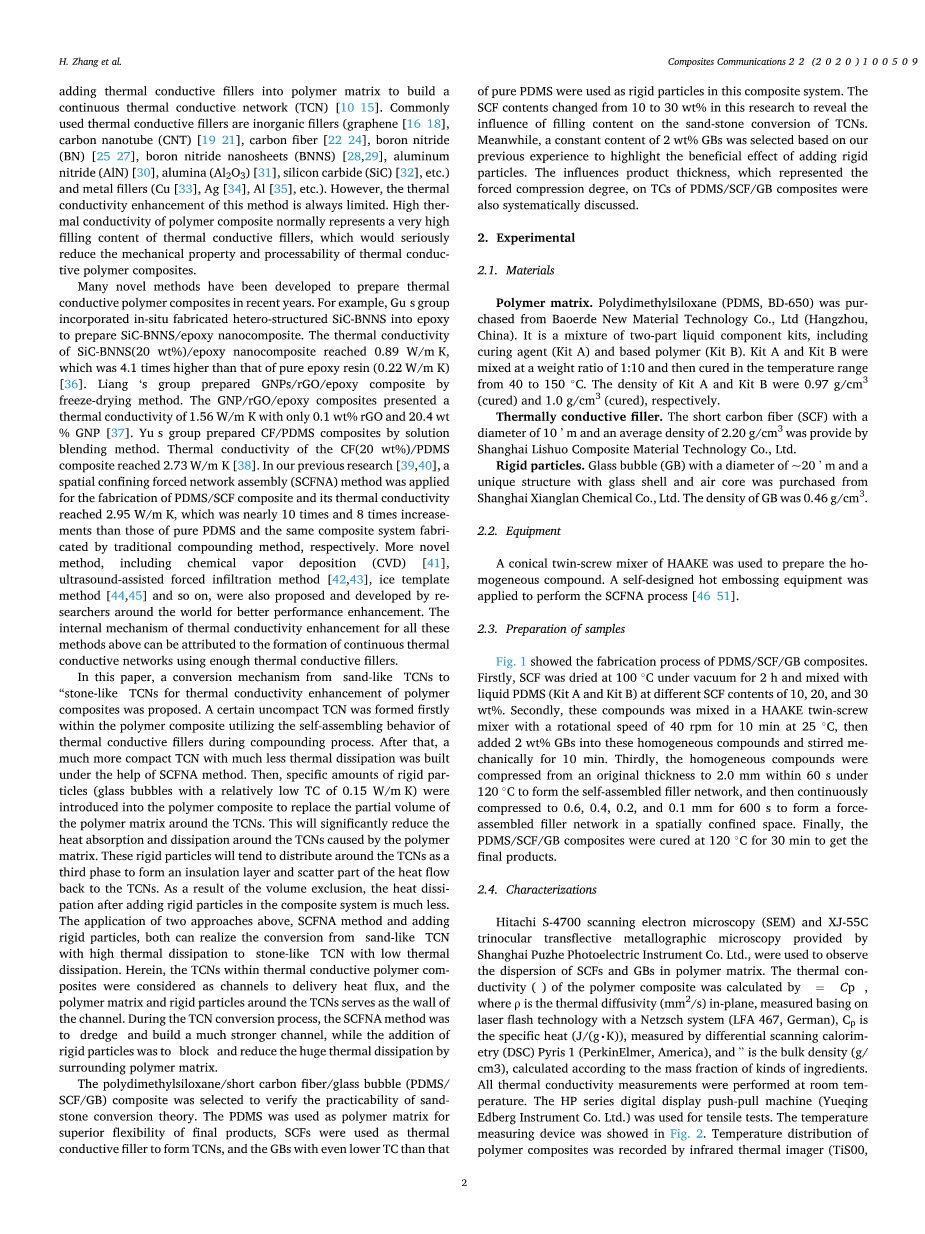

英语原文共 8 页,剩余内容已隐藏,支付完成后下载完整资料
A R T I C L E I N F O
Keywords:
Thermal conductivity enhancement Conductive network conversion Polymer composites
A B S T R A C T
Different from traditional compounding methods, a conversion method from “sand-like” to “stone-like” conductive network aimed at improving the thermal conductivity (TC) of polymer composites was proposed in this paper. Herein, “sand-like” and “stone-like” channels represented the thermal conductive networks (TCNs) with high and low thermal dissipation performances in polymer composites. The densification of TCNs and the adding of specific rigid particles were found to be two effective ways to realize the conductive network con- version from “sand-like” to “stone-like”. In this research, the polydimethylsiloxane/short carbon fiber/glass bubble (PDMS/SCF/GB) composite was selected to verify the practicability of this conversion theory. The SCF contents changed from 10 to 30 wt% to reveal the influence of filling content on the sand-stone conversion of TCNs. A constant content of 2 wt% GBs was selected based on our previous experience to highlight the beneficial effect of adding rigid particles. Meanwhile, the influence of product thickness on the PDMS composites was also systematically investigated. The TC of PDMS/SCF/GB composite with 0.1 mm thickness reached 11.690 W/msdot;K,
42.30 times higher than that of pure PDMS (0.27 W/msdot;K). Moreover, the superior flexibility and mechanical
property of final product provided convenience for their application as thermal management materials in electronics.
- Introduction
With the rapid development of microelectronics, 5G communication equipment, high-power LEDs, energy storage materials and other tech- nologies, the rapid heat accumulation in related components is un- avoidable. It will seriously affect the stability and reliability of electronic equipment [1,2]. Some research result shows that the performance of electronic equipment and components will present 10% reduction with
every 2 ◦C temperature increasement. In the field of energy storage, the
thermal conductivity (TC) of material is the key factor that affects the heat transfer ability and energy storage rate. Under this background, thermal conductive polymer composites have already become one of the key materials in many important engineering fields.
Polymer materials have excellent properties such as light weight, high flexibility, good chemical corrosion resistance, and convenient processing, which can meet the requirements in many applications. However, the thermal conductivities of most polymer materials were relatively poor (0.1–0.5 W/msdot;K) and couldnrsquo;t meet the requirements of efficient heat conduction/dissipation capacity in the application
situations mentioned above [3–5]. Therefore, there exits great theoret- ical and practical significance to explore the methods for thermal con- ductivity enhancement of polymer materials. At present, the research in this field has encountered a big bottleneck. Although the significant enhancement of thermal conductivity by orders of magnitude is theo- retically feasible, the actual enhancement results are often not satis- factory. The introduce of new ideas and new methods for thermal conductivity enhancement are highly essential to achieve greater breakthroughs.
The synthesis of intrinsic thermal conductive polymer materials and the fabrication of thermal conductive polymer composites are two main approaches to obtain polymer-based material with high thermal con- ductivity. Compared with the low fabrication efficiency, cumbersome synthesis process, and high cost for the synthesis of intrinsic thermal conductive polymer materials, the fabrication of the latter shows the advantages of easy operation, low cost, suitable for industrial produc- tion, and has already become the mainstream development direction of thermal conductive polymer materials [6–9]. Till now, it is a common method to enhance the thermal conductivity of polymer composites by
* Corresponding author.
E-mail address: sunjingyao@mail.buct.edu.cn (J. Sun).
https://doi.org/10.1016/j.coco.2020.100509
Received 12 August 2020; Received in revi
剩余内容已隐藏,支付完成后下载完整资料
资料编号:[257159],资料为PDF文档或Word文档,PDF文档可免费转换为Word
您可能感兴趣的文章
- 以葡萄糖为燃料在可见光下高效催化 驱动的微米马达外文翻译资料
- 氯离子电池:可充电电池家族的新成员外文翻译资料
- 用Lewis酸性熔盐反应合成纳米层化MAX相和MXenes的元素置换方法外文翻译资料
- a β钛合金在水溶液中的应力腐蚀开裂机制外文翻译资料
- 聚二甲基硅氧烷复合材料中的导电网络从“沙状”转变为“石状”来增强导热性外文翻译资料
- 磁性Ag3PO4 / Ag / NiFe2O4复合材料的合成及其光催化和磁分离外文翻译资料
- 气相包络行为对等离子体电解除膜的影响外文翻译资料
- 新型时效硬化镁锂钪合金的开发外文翻译资料
- H20在清洁和氧预吸附的Cu(l11)表面上的覆盖率依赖性吸附,解离和聚集:DFT研究外文翻译资料
- 可见光驱动的有机催化原子转移自由基聚合外文翻译资料


